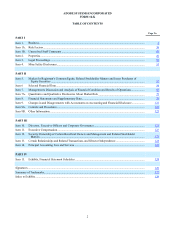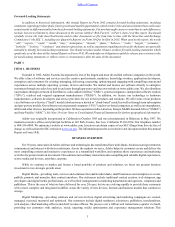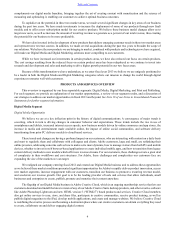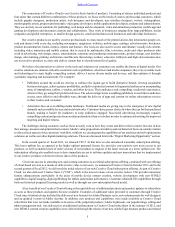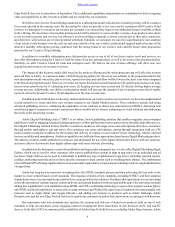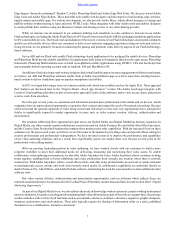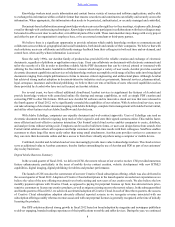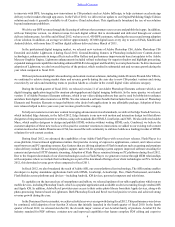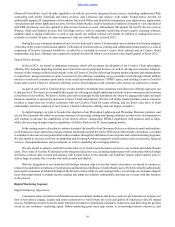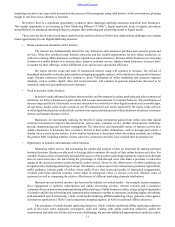Adobe 2012 Annual Report Download - page 6
Download and view the complete annual report
Please find page 6 of the 2012 Adobe annual report below. You can navigate through the pages in the report by either clicking on the pages listed below, or by using the keyword search tool below to find specific information within the annual report.
6
Edge Tools & Services to subscribers in September. These additional capabilities demonstrate our commitment to deliver ongoing
value and capabilities as they become available and are needed by our customers.
We believe our Creative Cloud offering, marketed as a subscription model with attractive monthly pricing, will be a catalyst
for revenue growth in the coming years. By increasing the value we provide to our core creative customers with Creative Cloud
services, we anticipate we can grow our revenue per customer over time as they begin to use additional features available to them
in the offering. We also believe the monthly pricing model will be attractive to users of older versions of our products who desire
to use our latest releases and services, but who have not been willing to upgrade to newer versions due to their price sensitivity,
and, therefore, will increase our revenue potential with them. Similarly, we anticipate we can drive significant new user adoption
of our creative tools business over the next several years outside of our core creative professional targeted market because of the
attractive monthly subscription pricing combined with the strong brand of our creative tools and the broad value proposition
provided by our Creative Cloud offering.
In addition to a monthly subscription price that provides access to use of all of our latest creative tools and services, we
also offer subscription pricing for Creative Cloud for some of our key point products, as well as for users in the education market.
Similarly, we offer Creative Cloud for team and enterprise users. We believe the mix of these offerings will drive new user
acquisition and increase our revenue over time.
The impact of this business model shift based on the product offering and the subscription pricing will affect the revenue
and cash flow to Adobe. As customers make a shift from paying upfront for the use of our software in the perpetual model to the
new subscription model where they pay over time, reported revenue and cash flow will be lower in the short term when compared
to the historical perpetual model. However, over time we expect this business model transition will significantly increase our long-
term revenue growth rate by (1) attracting new users, (2) keeping our user base current and (3) thereby driving higher average
revenue per user. Additionally, our shift to a subscription model will increase the amount of our recurring revenue that is ratably
reported, driven by broader Creative Cloud adoption over the next several years.
In addition to the shifts in how we develop, market and license our creative tools to our customers, we have also implemented
several initiatives to create and drive new revenue streams in our Digital Media business. These initiatives include delivering
advanced publishing services, enhancing the capabilities of our solutions to utilize new innovations in HTML5, delivering new
touch-based apps to expand our content creation user base to mobile device owners, enhancing our video solutions and addressing
the needs of the knowledge worker.
Adobe Digital Publishing Suite (“DPS”) is an online, hosted publishing solution that enables magazine and newspaper
publishers to deliver engaging, branded reading experiences of their publications to an extensive array of mobile and tablet devices.
Our Digital Publishing solution utilizes flexible e-commerce models to sell single issues and subscriptions directly to consumers
through mobile marketplaces and app stores. Our customers can create and enhance content through integration with our CS6
tools to enable a complete workflow for the creation and delivery of content via our Content Viewer technology, which is utilized
by users on tablets and smartphones. Analytics capabilities are built into these apps and are based on our Digital Marketing products.
The analytics features enable publishers to measure and understand the use of the digital editions they deliver with our solutions,
and more effectively monetize their digital edition apps with more relevant advertising.
In addition to the Enterprise version that publishers and large media companies use, we also offer Digital Publishing Single
Edition, which can be used by other customers who want to publish their content as apps in app stores on an individual and ad
hoc basis. Single Edition can be used by individuals to publish any type of publication to app stores, including research reports,
catalogs, marketing materials and even more specific consumer-related content such as wedding photo albums. The combination
of our different DPS offerings significantly increases our market opportunity to target anyone wanting to deliver a digital publication
via app stores.
Adobe has long been an innovator in helping drive the HTML standards process and then delivering the best tools in the
market to create content based on web standards. The ongoing evolution of new standards, including HTML5, and their adoption
in popular browsers, become significant catalysts for revenue growth in our solutions. To address this opportunity, we are innovating
across the spectrum of content creation, content delivery, and content display in browsers and mobile apps. Our innovation includes
adding new capabilities to web standards such as HTML and CSS, contributing technology to open source projects such as jQuery
(an HTML and JavaScript library to assist with creating websites) and Webkit (the open source foundation for many popular web
browsers such as Apple Safari and Google Chrome), and adding new features to products such as Adobe InDesign, Adobe
Dreamweaver and the new Edge Tools & Services to enable our customers to utilize these innovations occurring in web browsers.
Our innovation with web standards also includes the creation and delivery of brand new products built on top of web
standards to help our customers create engaging content leveraging the latest innovations in web browsers on PC and non-PC
devices. In the fall of 2012 we announced the availability of Adobe Edge Tools & Services, including Adobe Edge Animate, Adobe
Table of Contents


